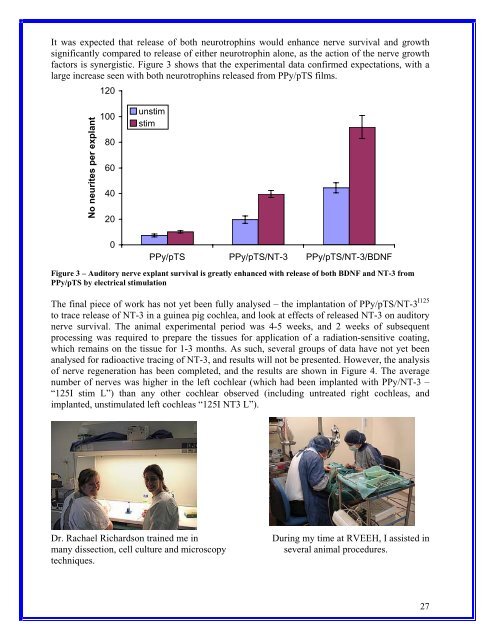Annual Report 2007 - The Australian Nanotechnology Network
Annual Report 2007 - The Australian Nanotechnology Network
Annual Report 2007 - The Australian Nanotechnology Network
Create successful ePaper yourself
Turn your PDF publications into a flip-book with our unique Google optimized e-Paper software.
It was expected that release of both neurotrophins would enhance nerve survival and growth<br />
significantly compared to release of either neurotrophin alone, as the action of the nerve growth<br />
factors is synergistic. Figure 3 shows that the experimental data confirmed expectations, with a<br />
large increase seen with both neurotrophins released from PPy/pTS films.<br />
No neurites per explant<br />
120<br />
100<br />
80<br />
60<br />
40<br />
20<br />
0<br />
unstim<br />
stim<br />
PPy/pTS PPy/pTS/NT-3 PPy/pTS/NT-3/BDNF<br />
Figure 3 – Auditory nerve explant survival is greatly enhanced with release of both BDNF and NT-3 from<br />
PPy/pTS by electrical stimulation<br />
<strong>The</strong> final piece of work has not yet been fully analysed – the implantation of PPy/pTS/NT-3 I125<br />
to trace release of NT-3 in a guinea pig cochlea, and look at effects of released NT-3 on auditory<br />
nerve survival. <strong>The</strong> animal experimental period was 4-5 weeks, and 2 weeks of subsequent<br />
processing was required to prepare the tissues for application of a radiation-sensitive coating,<br />
which remains on the tissue for 1-3 months. As such, several groups of data have not yet been<br />
analysed for radioactive tracing of NT-3, and results will not be presented. However, the analysis<br />
of nerve regeneration has been completed, and the results are shown in Figure 4. <strong>The</strong> average<br />
number of nerves was higher in the left cochlear (which had been implanted with PPy/NT-3 –<br />
“125I stim L”) than any other cochlear observed (including untreated right cochleas, and<br />
implanted, unstimulated left cochleas “125I NT3 L”).<br />
Dr. Rachael Richardson trained me in During my time at RVEEH, I assisted in<br />
many dissection, cell culture and microscopy several animal procedures.<br />
techniques.<br />
27



